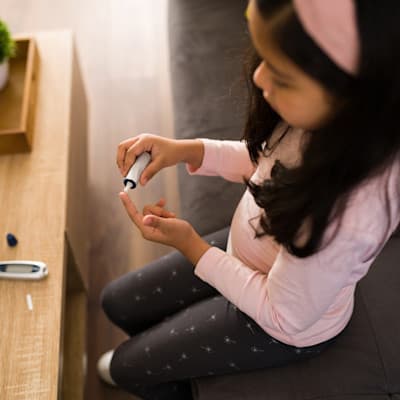Hypoglycemia: What Should You Do If Your Child Has Low Blood Sugar?
Learn how to recognize and treat low blood sugar in your child to keep them safe and healthy.

What your child eats, their energy, stress, illness or even a sunburn — all of these can cause changes in your child’s blood sugar. It’s normal for their blood sugar levels to go up and down throughout the day and night, and if it stays in a healthy range, it may not even be noticeable.
When your child’s blood sugar is too low (hypoglycemia), you need to take action to get their blood sugar levels back to a safe range. Without treatment, your child may be at risk for dangerous symptoms, such as fainting, seizures or a coma.
Fortunately, you can easily treat your child’s blood sugar — during the day or at night. Here’s what you should know about keeping your child’s blood sugar levels in a healthy range.
Recognizing Hypoglycemia: Symptoms to Look For
Early symptoms of hypoglycemia include:
Shaking
Sweating
Hunger
Mood changes
Paleness
Weakness
Fast heartbeat
Headache
Later symptoms include:
Blurry vision
Dizziness
Confusion
Poor coordination
Stubborn behavior
Extreme sleepiness
If your child’s blood sugar levels stay low and continue to drop, symptoms will get worse. This can lead to seizures or unconsciousness if not treated immediately.
If seizures or unconsciousness occur — or if your child cannot safely swallow — do not give them anything by mouth. You need to give them Glucagon or Baqsimi right away.
Daytime Low Blood Sugars
While your child is out and about during the day, there are three main factors that can impact their blood sugar levels:
Too little food
Too much insulin
Too much exercise
You should treat low blood sugars under 70 for children over 5 years old. For children that are younger than 5 years old, treat under 80 because they are not able to tell someone how they feel. Targets may be different for infants, toddlers or children of any age who Can’t speak. Be sure to talk to the Diabetes Team if you have any questions about when your child needs treatment.
Treating Low Blood Sugar During the Day
If you or your child notice symptoms of low blood sugar during the day, it’s important to begin treatment immediately.
Nighttime Low Blood Sugars
Keeping your child’s blood sugar higher at bedtime and overnight will help to prevent their blood sugar from dropping while they’re sleeping. The greatest risk for seizures due to a low blood sugar occurs during the night.
Nighttime low blood sugars can occur because of:
Exercise during the day, which can cause delayed drops in blood sugar
Insulin doses that are too high
Not eating enough carbs for the amount of insulin given
Difficulty detecting symptoms of low blood sugar because your child is asleep
If your child is 5 years or older, they should have a nighttime blood sugar range of 90-150. If they are younger than 5 years old, their blood sugar range at night should be 100-180.
Treating Low Blood Sugar At Night
There are two ranges of blood sugars to treat if your child is low because they need more carbohydrates if their blood sugar is less than 50.
Carbohydrate Ideas
Whether during the day or at night, it’s important to give your child the right amount of carbohydrate to get their blood sugar levels back to normal. Always have treatment for lows with your child.
Remember:
1⁄4 cup = 2 ounces
1⁄2 cup = 4 ounces
Questions?
Contact the Children's Nebraska Endocrinology & Diabetes team at 402.955.3871 to find more about how to safely manage your child’s diabetes
